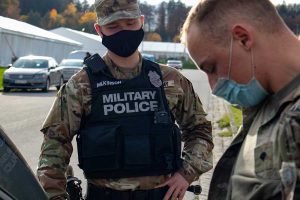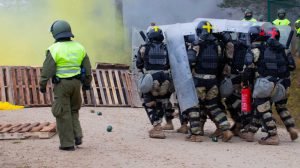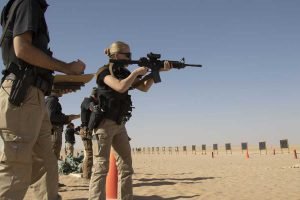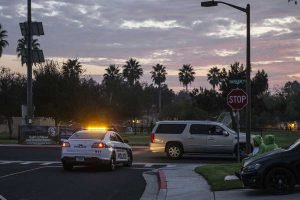Examining the Differences Between Military Police and Civilian Police in Their Approach to Law Enforcement

Sgt. Josh Wilkinson, a military police soldier with the 29th Military Police Company, Maryland Army National Guard, conducts a simulated shoplifting search during a Joint Multinational Readiness Center exercise rotation in Hohenfels, Germany, on Nov. 2. The soldiers are preparing to deploy to Kosovo. Photo by Sgt. Zachary M. Zippe, courtesy of the U.S. Army National Guard.
One night, at an on-base bar at a U.S. Army air installation in South Korea, a soldier drank too much. Not exactly breaking news, but his first sergeant and company commander happened to be at the club, and after realizing the “super-drunk” soldier was no longer capable of behaving himself, they sent him home.
The soldier left, but then returned to the club—with a knife. Somebody called the military police. When Brenna Toel arrived, she could tell by the way the intoxicated soldier stood, and later by the way the shank looked after the police took it from him, that he had “been in some fights,” she said.
But rather than pull her gun—or a taser or a club—Toel cajoled, reasoned, and pleaded with the soldier to leave the club peacefully, using the de-escalation techniques ingrained in her during her training.
For three hours.
“I talked him down for three hours instead of having anybody else get hurt,” she said. “It never entered into my head to just pull my weapon and try to get him to go down like that. Never once.”
Like much of the United States in the past few months, Toel has watched the explosive news and accusations of improper police response and brutality, specifically against Black Americans—and the loud outcry that has followed.
May 25 video footage showed Minneapolis police officers kneeling upon the neck of 46-year-old George Floyd until he died. After the video went viral, protests erupted across the United States. Unrest followed—including peaceful demonstrations, as well as property destruction and looting—as did clashes between protesters and police.

But amid swirling and often divisive conversations about civilian police brutality and the role of police in American society, another police demographic largely has been left out of the national conversation: military police.
And while MPs have their own issues to deal with—from a lack of transparency, accusations of not caring enough about women and minorities while conducting investigations, a tendency toward inequity in punishments based on a commander’s discretion, and a trend toward violence among military veterans who become civilian police—former service members say civilians could learn from the military’s habit of responding to each call with the understanding that it could involve a co-worker, a friend, a person dealing with a mental health crisis connected to service, or a pushed-to-the-limits family member. In other words, the MPs act as members of a community.
This, they say, in addition to differences in military versus civilian police environments, mindset and training, and pride in combat experience is why there are very few stories of military police brutality.
No Civilian Equivalent
In Toel’s case, law enforcement was the family business: Her father worked as a cop for 20 years for the city of Sacramento, her great-grandfather was a cop in Ireland before doing the same job in San Francisco, and numerous uncles and cousins served in law enforcement. Toel joined the Army after 9/11 and spent five years in her military job of choice, dealing with everything from on-base domestic-violence calls to writing on-base speeding tickets.
But as she wrote tickets and calmed families, she was aware at every moment that she could talk to the person’s commander. She knew that rank would play a role in how she handled a situation. She knew she could pull upon several base resources—from substance abuse counseling to mental health workers to family services—to help her in her job.
Even beyond that, comparing military policing to civilian policing is like comparing tanks to taxicabs.
“One of the biggest things there for me is that we do the same job as civilian police but everybody we deal with is trained to kill, and yet we don’t have all of the problems that civilian police have,” Toel said.
First, there are huge differences between how a military base looks and how the “real world” operates: Unit commanders have a say in everything from punishment for coming up hot for marijuana on a urinalysis to driving under the influence to missing child-support payments. In arguably no other place in the United States is one’s behavior so tied to one’s job: If a Marine gets caught misbehaving on base, his boss is the first one, after the military police, to know. If a soldier’s spouse files a domestic abuse complaint, the accused’s commander knows. Service members aren’t allowed to take a vacation, go to college, or even get dental work done without permission from someone in their chain of command.
And while a commander might be willing to let a first offense slide—particularly if a unit is getting ready to deploy or has just returned from deployment—two or three drunk fights at a bar could mean the end of a career with a pattern of misconduct discharge.
The military world is “more engaged” than civilian law enforcement “by virtue of a commander’s authorities and responsibilities to sustain good order and discipline, and ensure the safety, security, and welfare of the personnel and property under their charge,” Capt. Casey Littesy, a spokeswoman for Headquarters Marine Corps, told The War Horse in an email, noting that jurisdiction for Marine MPs is “limited to Marine Corps property,” where the chain of command is in charge.
“This enables Marine leaders to identify indicators of potential misconduct early, intervening to prevent a situation before it occurs and before (law enforcement) response is required,” she said.

People in the military are also held accountable by anyone in the military who outranks them. Any higher-ranking Marine might remind a lower-ranking Marine she needs a hat if she walks out of a building without one on her head; just as any higher-ranking soldier can tell a drunk lower-ranking soldier he needs to go home and sober up.
Try telling the neighbor kid in Miami to take his hands out of his pockets and see what happens.
But rank can work against military police, too. One former Marine corporal said that during traffic stops, he would call another Marine to take charge when he pulled over colonels or gunnery sergeants because they outranked him. Because of the obedience and respect for higher ranks that is built into the military system, that interaction was best handled by a civilian counterpart or higher-ranking Marine.
There’s also a huge sense of community, and military police often work with—or socialize with—the same people they may later pull over for blowing through a stop sign. For example, a company of MPs may deploy with an infantry unit and patrol with them or act as back-up in an emergency. This creates a sense of camaraderie that’s not often seen in the civilian world.
And even the challenges of the military may add needed empathy during tense moments.
Navy veteran Julia Hutson worked as a master at arms—the Navy’s version of the MP—and now has a master’s degree in criminal justice. Veterans she knows in the civilian police world are better at handling mental health calls, she said, as many veterans have friends or know someone with post-traumatic stress or struggling with other mental health challenges. Many also have experience staying calm under pressure and not looking for trouble.
For police officers who are veterans, “Being a cop isn’t the coolest thing we’ve ever done,” said Hutson, who deployed as an inmate guard at the Guantanamo Bay detention camp, a high-security military prison in Cuba, as well as to Afghanistan in 2013 on a female engagement team with special operations forces. “So I don’t go into work itching to dig into a bunch of nonsense.”
Days Look Different
Military police deal with many of the same calls civilian cops do—domestic disturbances, DUIs, suicide attempts—but their days look different.
For Hutson, her job as a master-at-arms stands worlds apart from that of her job as a Texas police officer: It’s a “different spectrum of reality.”
Every person who enters a military base must present some form of identification—military ID, driver’s license, passport—to military police officers standing guard at the entrances. All visitors’ information is recorded, and there must be a good reason for them to be on base.
Generally speaking, everyone on base is supposed to be there, and if they’re service members, any criminal background is likely to be minor, both because people with criminal backgrounds aren’t allowed in the military and because service members who commit crimes are booted out.
“You’re already kind of sorting through and filtering the people that you would even have contact with,” Hutson said, “the vast majority of them having security clearances or background checks.”
Civilian communities and cops often deal with drugs or gangs and the people entrapped in their snares, said one recent veteran who spent five years as an active-duty MP with the Marine Corps and one year in the same role in the Army National Guard, and then served as a civilian cop with the Marine Corps. He asked to remain anonymous because he is trying to get picked up in the Navy reserves as a cop.
But even if a service member grew up influenced by drugs or gangs, “all of that was lost when they joined the military,” he said. “In the military, each individual is pretty much broken down and rebuilt in a way the military wants them to act.”
In his years of working with military police, arrests never amounted to anything more hands-on than locking a person into handcuffs.
For Hutson, who now works in a large Dallas suburb as a civilian police officer, an average day sees about 15 calls.
In the military, “you wouldn’t see that many calls, first of all, and you wouldn’t see the type of calls, the diversity, and numbers of calls that you would see in a city, even a small city,” Hutson said.
The Marine Corps declined to comment on how many calls its military police see in an average day.
The Goal Was Always De-escalation
For Toel, the training made the difference. In the civilian world—as well as in movies—police often respond with weapons drawn.
“People just assume that’s how cops are supposed to show up,” she said.
But that was not what she learned at her military police academy.
“The goal was always de-escalation,” she said. “We were taught in basic training, ‘shoot to kill.’ But as police, we were taught to de-escalate.”
And that makes sense: Toel wore the same uniform as did the soldier who showed up at the club with a knife—they were part of the same “team.”
Military police are trained in tactics “similar to that of civilian law enforcement” officers, Littesy said, including defensive tactics, basic investigations, searches and seizures, incident response, reporting, field interviews, weapons training, use of force, and traffic stops.

Most of the training military police get is similar to the civilian world, just condensed into a shorter amount of time, another Marine MP veteran said, noting his civilian training was more than double his military police training. He asked to remain anonymous because he was recently hired by a local sheriff’s department.
And, unlike in the civilian world, most MPs carry weapons.
In the Marine Corps, all military police carry a gun and carry nonlethal weapons, like a baton and pepper spray.
It was harder to get a weapon in civilian law enforcement, Hutson said, where there is a higher expectation of proficiency before a police officer can carry.
Hutson’s military police training was more textbook and PowerPoint-oriented, she said, while her civilian training was “more realistic” and put her in situations that were similar to what she now sees on the city streets.
But her military police training was more than sufficient, she says.
“I don’t think they need it to be as intense as civilian law enforcement,” she said. “They don’t see the things that civilian law enforcement does on a day-to-day basis.”
Records Are Not Easily Accessible
Still, there were several high-profile military moments in 2019, most dealing with active shooters.
On Dec. 6, 2019, a Saudi Arabian military student training in the United States opened fire on a Naval Air Station Pensacola, Florida, classroom.
Four people were killed, including the shooter, with eight others injured. Base security officers and local Escambia County, Florida, law enforcement officers shot and killed the gunman. Two deputies who approached the shooter were injured.
In April 2019, a 25-year-old male sailor was shot and killed by base security at Naval Air Station Oceana in Virginia, after shooting a female sailor, who survived, in the parking lot. The incident was later deemed a “domestic” incident, Navy Times reported.
The Navy also has been investigating how base police and security troops responded to a “terrorism-related” gun battle at its Corpus Christi, Texas, base in May. A Navy Security Force officer was shot by the suspected gunman driving onto the base, but also was able to “roll over and hit the switch that raised a barrier, preventing the man from getting onto the base,” officials told The Associated Press at the time.
Unlike civilian crimes in a police blotter, reports, arrests, and investigations on base usually need to be obtained via a Freedom of Information Act request.
Records of many of the daily crimes that would require military police intervention are not easily accessible.
In April, military police faced criticism after Army Spc. Vanessa Guillen disappeared at Fort Hood, Texas. Her death inspired protests because, according to her lawyer, she planned to file a sexual harassment complaint, and because women—and especially women of color—say it is difficult for them to make their voices heard in the military when they’re being harassed or assaulted. Investigators later said Guillen was bludgeoned to death on base by a fellow soldier. Seven other Fort Hood soldiers have been found dead so far in 2020 after being reported missing, leading to complaints that MPs there are not properly investigating missing people cases.
They Don’t See the Things Civilian Law Enforcement Does
Interactions with police officers are more often being captured on video, which means the world has been able to witness instances of police brutality and abuse. But video recording, unlike audio recording, is often prohibited on many areas of military bases, so troops interacting with military police might not even think to record.
Cell phone cameras, dashboard cams, and police body cameras are a big reason more police interactions have been coming into public light and scrutiny.
It was an onlooker’s cell phone footage (along with security and surveillance cam footage) that first gave audio and visuals to George Floyd’s death—and later-released police body camera footage that gave us more details.
And while recent studies show body cameras don’t influence police officers’ behavior unless they are used and reviewed properly, at least half of civilian departments have them—and military police trail far behind in acquiring them.
In 2017, Marine Corps Air Station Miramar, California, was the first military installation to implement a body camera program throughout its Provost Marshal, or military police, office, according to the Marine Corps.
Miramar military police work “closely with the San Diego Police Department,” Lt. Col. Scott Rooker, then-Miramar Provost Marshal, said in a 2017 Marine release. “They were one of the first in the nation as a major city to take on the body-camera challenge. They talked to us a lot about their training, policies, and procedures, and some of the great results they were seeing.”
But the Marine Corps as a whole is still “doing an assessment on the use of body cameras,” Littesy said, viewing it as an “emerging capability.”

Though his unit did not have body cams when he was there (it does now), the Marine MP veteran said he often used an audio tape recorder at traffic stops for his own protection and to back up his reports.
Problems of Their Own
But as veterans leave the military and become civilian police, problems have arisen. In fact, the officer who knelt upon George Floyd’s neck first served as a military police officer in the Army Reserve. After eight years in the military, Derek Chauvin left with the rank of specialist—one step up from a private first class and one below a sergeant.
Many places, including Texas—where Hutson was hired while she was still into her eight years in the Navy Reserve—put a premium on hiring veterans in their police departments. That group consists of both veterans who served as MPs as well as in other job specialties, such as infantry or communications.
Law enforcement was one of the top-10 career fields for veterans in 2019, according to a survey by the Navy Federal Credit Union in conjunction with Hire Heroes USA. It was “most suited for, and comparable to military experience and skill,” the survey said.
But does a military veteran necessarily bring a better background into a civilian police department?
Some critics argue that America’s police system has become paramilitary in rank and training, and has even added military equipment. A small West Virginia town, for example, recently picked up a military mine-resistant ambush protected tactical vehicle—designed to fight improvised explosive device attacks. And with increased militarization comes increased violent behavior by police officers, research has shown.
Though largely unstudied, there is reason to believe veterans may also bring more force with them to civilian law enforcement.
Researchers at the University of Texas School of Public Health in Dallas published a study in the Journal of Public Health in 2018 finding that cops who were military veterans were more likely to discharge their weapons than their nonveteran cop counterparts.
Dallas Police Department officers who were military veterans who had deployed were “2.9 times more likely to be in a shooting” on duty as law enforcement officers compared to non-military-veteran police officers, the research found.
“Future studies should identify the effects of traumatic exposures—including combat exposure—on the behavior of veteran” cops, the researchers wrote.

“Military members are people, too,” a civilian Marine police field training officer told The War Horse on the condition of anonymity due to his current job. “They commit the same crimes people out in town commit. Some of them are pretty heinous.”
“Nobody knows what we military police actually do because our crime stats don’t get put out to the public,” he wrote.
In the civilian cop world, the “blue wall of silence” is an unofficial oath of loyalty, one that says, “cops don’t snitch on cops.” They protect each other.
The military, however, is at least taught to “put the good of the institution before the individual,” Dwight Stirling, a reserve JAG officer and CEO of the Center for Law and Military Policy, wrote in The Conversation in December 2019. The military stresses the importance of organizational loyalty over personal allegiances.
Service members answer to the laws of the Uniform Code of Military Justice system, or UCMJ, which can sometimes bring harsher penalties to service members than civilian penalties might. Poor decisions can be detrimental to more than just a service member’s job—but their whole life, not to mention the possibility of marks on a federal record.
As the nation wrestles questions of racism and policing policies, military police schools are at least pondering the same tensions.
In an early June event in Fort Leonard Wood, Missouri, junior Army police officers were invited to discuss “social issues currently facing this country,” like racism and civil unrest.
“Amidst the protests across the country, we determined that if the rest of the country was in turmoil, then our students would be feeling the same pain, anger, and concern for their families and communities,” said Col. Matthew Gragg, U.S. Army Military Police School training and education director, in an Army press release.
Soldiers discussed how policy change can be achieved in the Army. Some of the ways include new Army policies aimed at rooting out poor military leadership, Army Military Police School Commandant Brig. Gen. Brian Bisacre said at the event.
“Policy alone doesn’t change things—people do,” Bisacre said. “There are bad leaders, but the Army is trying to change that.”
Just as civilian police could learn from MPs, MPs could also learn from civilian police experiences.
“There are problems,” Toel said. “There are, without a doubt, problems—and there are bad military police officers, obviously. But nowhere near what you see in the civilian world.”
Editors Note: This article first appeared on The War Horse, an award-winning nonprofit news organization educating the public on military service. Subscribe to their newsletter.

Coffee or Die is Black Rifle Coffee Company’s online lifestyle magazine. Launched in June 2018, the magazine covers a variety of topics that generally focus on the people, places, or things that are interesting, entertaining, or informative to America’s coffee drinkers — often going to dangerous or austere locations to report those stories.
BRCC and Bad Moon Print Press team up for an exclusive, limited-edition T-shirt design!
BRCC partners with Team Room Design for an exclusive T-shirt release!
Thirty Seconds Out has partnered with BRCC for an exclusive shirt design invoking the God of Winter.
Lucas O'Hara of Grizzly Forge has teamed up with BRCC for a badass, exclusive Shirt Club T-shirt design featuring his most popular knife and tiomahawk.
Coffee or Die sits down with one of the graphic designers behind Black Rifle Coffee's signature look and vibe.
Biden will award the Medal of Honor to a Vietnam War Army helicopter pilot who risked his life to save a reconnaissance team from almost certain death.
Ever wonder how much Jack Mandaville would f*ck sh*t up if he went back in time? The American Revolution didn't even see him coming.
A nearly 200-year-old West Point time capsule that at first appeared to yield little more than dust contains hidden treasure, the US Military Academy said.












